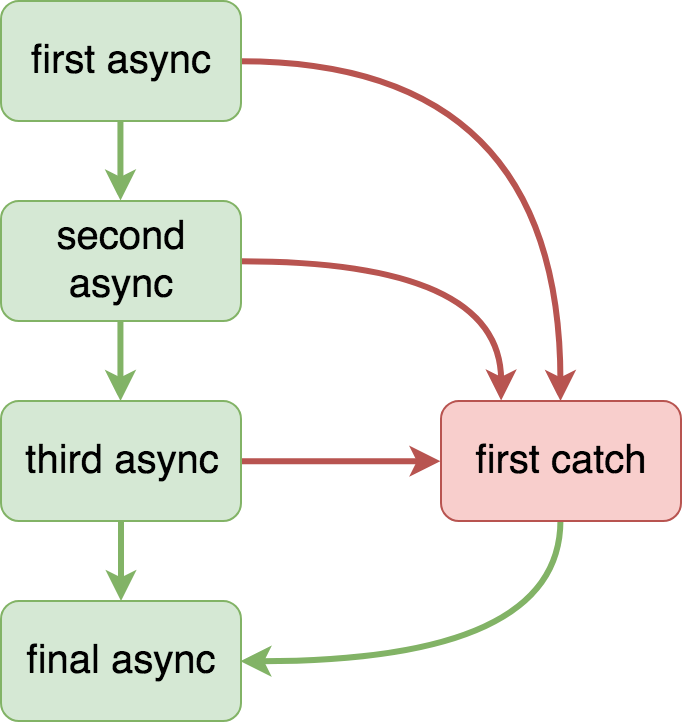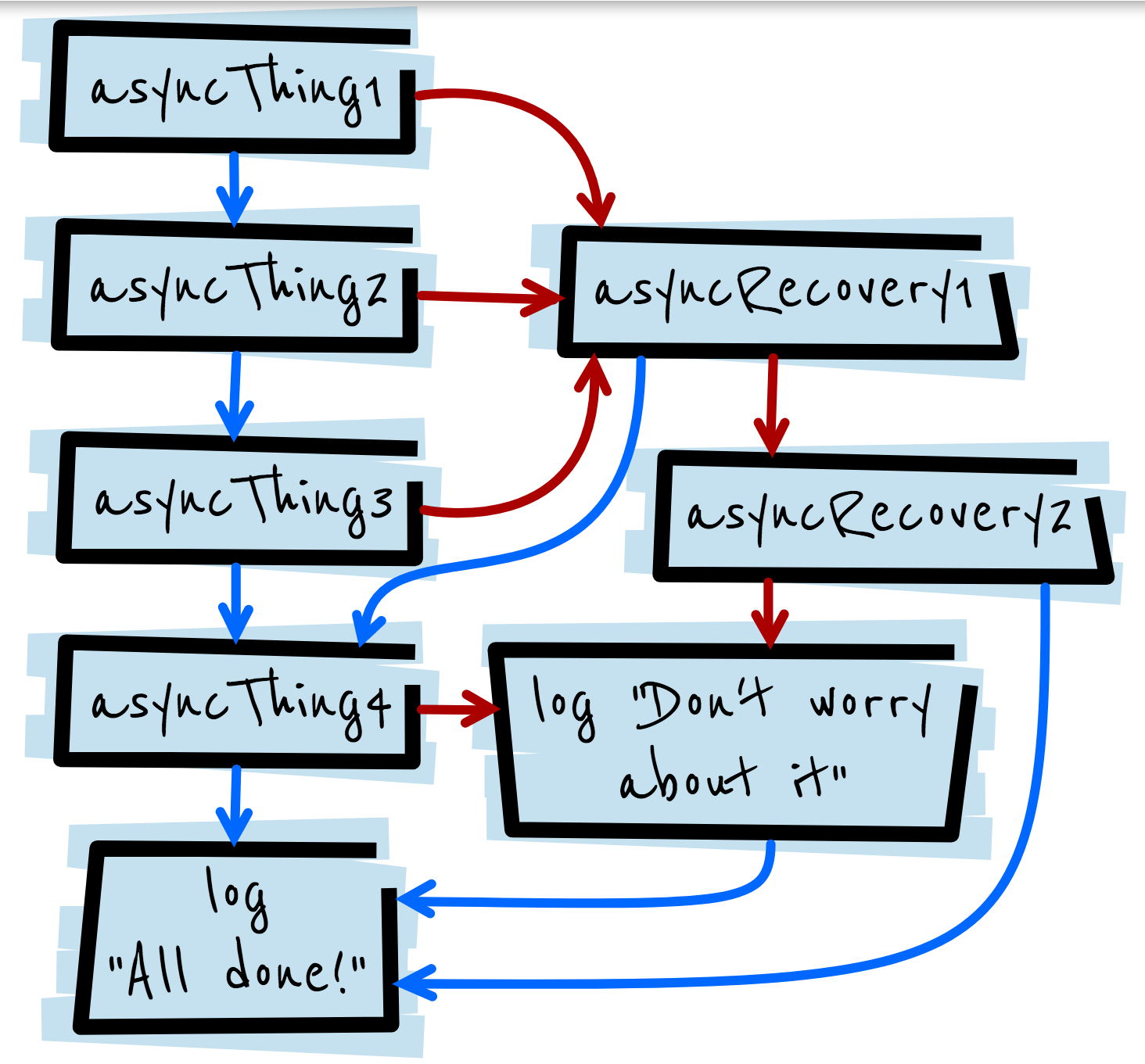
所謂良好的使用者體驗,有個基本要求:「能即時回饋使用者的互動」。在 Mobile Native,常利用多線程(Multi-threading)分散主線程(main thread)的負擔,讓其能即時響應使用者點擊等事件。反觀 web 端的霸主 JavaScript,卻是易被阻塞的單線程(single-threaded)語言,不過藉由 Event Loop 的設計,仍可達成非同步操作,線程不至完全阻塞,或多或少彌補了單線程的不足。
眾所周知,Concurrency is hard!設計不良的非同步程式,絕對會讓你痛不欲生。本文將簡單介紹 Promise 這個現代 JavaScript Concurrency Features,讓 JS 新標準帶你從地獄回到另一個煉獄人間。
(撰於 2017-06-12,基於 ECMAScript 6+)
Definition
Promise 是一個非同步操作的代理物件(proxy object),表示這個非同步操作在未來終將實現(或產生錯誤),並同時取得該操作的結果值。Promise 並不侷限在 JavaScript 中,它是一個概念,有時候又稱為 Deferred、Future,維基百科有詳盡的介紹。
Features
Promise 是 ES6 引入的標準之一,主要實踐了 Promise/A+ 組織訂定的標準,該標準平息了社群長期對 Promise 實作的爭論,使得各家的非同步操作終於有了相同的 API。以下是個人認為 ES6 Promise 的幾個重要特色:
- 截止當前(2017.6),Promise 在瀏覽器的支援程度已接近 90%。(主流瀏覽器僅 IE 11 不支援)
- 統一、可預期的 callback 調用與 error handling 流程。
- callback 定義清楚完善,沒有重複調用或改變狀態的疑慮。
- 將有序的 promises 串連起來(promise chaining),解除 callback hell 問題。
- 可自由組合多個 promises(promise composition),實作 sequential 或 paralleling 的 promise chain。
Terminology
開始之前,先了解 Promise 相關的術語:
- promise:一個 object 或 function,帶有符合 Promise/A+ 規範中的
thenmethod。 - thenable:有
thenmethod 的 object 或 function。 - value:任何合法的 JavaScript 值(
undefined, thenable, promise 皆為合法的 value)。 - reason: promise 被 reject 的理由所包含 value,通常是
Errorobject。
Promise States
Promise 字面上的意思為「承諾」,實際上就是一種「保存非同步操作結果」的 object。一個 Promise 建構完成後,必為下列三種狀態之一:
- pending
- 狀態未定,之後狀態會轉移至 fulfilled 或 rejected。
- fulfilled
- 狀態已定,無法再轉移至其他狀態。
- 必須帶有一個 identity immutable 的 value(
===相等)。
- rejected
- 狀態已定,無法再轉移至其他狀態。
- 必須帶有一個 identity immutable 的 reason。
另外有個常提及的狀態,其實是個集合名詞:
- settled/resolved
- 狀態已定,可能是 rejected 或是 fulfillled。
Promise 的 state 一旦 resolved/settled,就無法再次改變狀態,這是 promise 非常重要的核心概念,也是給開發者安心的一個承諾。
Give Me a Promise
了解 Promise 物件有什麼 state 之後,我們來學習如何建構一個 Promise。一個標準的 Promise 結構大致如下。
const promise = new Promise((resolve, reject) => {
// if success
resolve(value)
// else failure
reject(someReason)
})
Promise 的建構式僅需一個 function parameter,而這個 function param 則帶有兩個 callback 性質的 function params(resolve、reject),這兩個 function params 的作用是「將 Promise 的 state 從 pending 轉移至 resolved/rejected」,主動調用時機如下:
- 當操作成功執行…
- 主動調用
resolve並傳入合法的 value。 - 該 promise 狀態轉移至 fulfilled。
- 主動調用
- 若失敗或出現例外…
- 主動調用
reject並傳入失敗的 reason。 - 該 promise 狀態轉移至 rejected。
- 主動調用
於是,可以很容易將傳統的 callback XHR 改寫成 promise 版本。
// The old way
const xhr = new XmlHttpRequest()
xhr.open('GET', someURL)
xhr.onload = () => response(xhr.responseText)
xhr.onerror = () => error(new Error (xhr.statusText))
xhr.send()
}
// Promise version
const promise = new Promise((resolve, reject) => {
const xhr = new XmlHttpRequest()
xhr.open('GET', someURL)
xhr.onload = () => resolve(xhr.responseText) // 調用 resolve,狀態變為 resolved
xhr.onerror = () => reject(new Error (xhr.statusText)) // 狀態變為 rejected
xhr.send()
})
慣例上,會將 promise 包在一個 factory function 中,方便建構新的 promise。
// 簡單的 http GET request promise version
function get (url) {
return new Promise((resolve, reject) => {
const xhr = new XmlHttpRequest()
xhr.open('GET', url)
xhr.onload = () => resolve(xhr.responseText)
xhr.onerror = () => reject(new Error (xhr.statusText))
xhr.send()
})
}
乍看之下,Promise 似乎比較複雜,但經過這些包裝後,再利用即將介紹的 then method ,產生可預期的非同步結果,promise 對調用者來說 ,絕對比起傳統 callback 更為穩健。
The then method
Promise 的 then 是 promise 最核心的元素,本質上就是「替 promise instancestate 添加 state 改變時的 callback function」。 method signature 如下
// return a Promise instance
promise.then(onFulfilled, onRejected)
其中 onFulfilled、onRejected 為兩個 callback,執行時機為 state 轉移:
- pending -> fulfilled:
onFulfilled - pending -> rejected:
onRejected
利用上一節透過 promise 包裝後的 XHR,實際看看 then 該如何用
get('https://httpbin.org/get').then(
// promise state 轉換為 fulfilled 時,執行 onFulfilled callback
value => { // value 為 promise 建構時,由 resolve(value) callback 傳入
console.log('I am resolved :)', value)
},
// promise state 轉換為 rejected 時,執行 onRejected callback
error => { // error 為 promise 建構時,由 reject(error) callback 傳入
console.log('I am rejected :(', error)
}
)
另外,onFulfilled 與 onRejected 兩個 callback 皆為 optional,我們可以只處理 success 的 case,也可以單純 handle errors。
// 忽略 error
get('https://httpbin.org/get')
.then(console.log)
// 只處理 error
get('https://httpbin.org/get')
.then(null, console.error)
// 只處理 error 也利用 `.catch` syntax sugar
get('https://httpbin.org/get')
.catch(console.error) // === .then(null, console.error)
Promise#catch同義於then的第一個參數傳入null->Promise#then(null, onRejected)
Promise Chaining
Promise/A+ 規範中,明確定義 then method 必須回傳一個 promise instance,使得 promise 可透過類似 functional programming 的鏈式操作,減少不必要的變數,讓程式碼一氣呵成,增加可讀性。
const promise = new Promise((resolve, reject) => { // 1
// heavy computation...
resolve(1)
// reject(new Error())
})
const promise2 = promise // 2
.then(value => {
console.log(`newValue === ${value}`)
// newValue === 1
return newValue + 1
})
promise2.then(newValue => { // 3
console.log(`newValue === ${newValue}`)
// newValue === 2
})
- 上例(1)中,我們創建了一個 promise instance,經過負責運算,value
resolve為 1,狀態變為 fulfilled。- 在(2),我們調用該 promise 的
thenmethod,將newValue+ 1 並回傳,這個newValue + 1將成為下一個 chained promise 在onFulfilledcallback 會取得的 value。- 在(3)又串連一個(2)回傳的
promise2,並將取得的newValuelog 出來,得到2。
我們可以看見,promise chaining 的 value 是透過 return keyword 來傳遞。以下講解不同的情況:
當 promise 執行成功
- 若
onFulfilled回傳一個 value,then回傳由該 value fulfilled 的 promise。
- 若
onFulfilled回傳一個thenable或promise,- 將嘗試 resolve 該
thenable或promise,取得其 result 並回傳由該 value fulfilled 的 promise。
- 將嘗試 resolve 該
- 若
onFulfilled執行發生錯誤,then回傳的 promise 會被該 error reason rejected。
當 promise 執行失敗
- 若
onRejected回傳一個 value,then回傳由該 value fulfilled 的 promise,錯誤不繼續傳遞,也稱為 promise recovery。
- 若
onRejected回傳一個thenable或promise,- 將嘗試 resolve 該
thenable或promise,取得其 result 並回傳由該 value fulfilled 的 promise。
- 將嘗試 resolve 該
- 若
onRejected執行發生錯誤,then回傳的 promise 會被該 error reason rejected。
在這附上 MDN 的流程圖示:

簡之,
onFulfilled、onRejected這兩個 callback 若有 return value,皆回傳帶有該 value 的 fulfilled promise。若執行過程中有 Exception,無論是否為自行拋出,皆回傳的 rejected promise,並帶有該 Exception。
我們再看一個複雜一點的例子,利用 MDN fetch API 來解釋
fetch('flowers.jpg') // 0 (first async)
.then(response => { // second async
if(response.ok) { // 1
return response.blob() // 2
}
throw new Error('Network response was not ok.') // 3
})
.then(blob => { // third async
var objectURL = URL.createObjectURL(blob) // 4
myImage.src = objectURL
})
.catch(err => { // first catch
console.log(`Your fetch operation failed: ${error.message}`) // 5
})
.then(() => { // final async
console.log('All done!') // 6
})
(0)fetch 這個 function 傳入 URI,回傳一個 promise
(1)若執行成功,then 接受到 fulfilled 的 value(response),並檢驗 response 的 status。
(2)若 status 為 ok,嘗試透過 blob method 將 response 轉換為 blob(回傳一個 promise resolved with blob)。
(3)如果 status 檢驗不成功,則直接拋出錯誤,該 then 回傳一個被該錯誤 rejected 的 promise 。
(4)若第一個 then fulfilled,執行這個 then 的 onFulfilled callback,並將 blob 轉換為 url。
(5)若上述任一步驟出錯,error 會繼續往下傳遞,直到被實作 onRejected callback 的 handler 捕捉。(本例為(5)的 catch)。
(6)若沒有錯誤,最終將執行這個 callback;由於(5)的 catch 回傳了一個 recoverable promise(回傳 undefined,無 throw error),因此就算(5)的 catch 有捕捉到 error ,仍然會執行(6)的 callback。

Promise Chaining Flow
這裡參考 Google Web Fundamentals - Promises 一章的範例,作為 Promise Chaining 的總結,圖中的紅色箭頭代表 rejected,藍色代表 fulfilled(recovery),碼、圖和著看,非常清楚。
有幾點再次提醒:
- 若 return 一個
thenable或promise,則等待該 value 被 resolve(類似 sequential promise composition)。 - 只要沒有 handler 實作
onRejectedcallback,promise 就會不斷往後傳遞 error。 - 任何 code block 拋出 Exception 例外,都會造成該 promise 被 reject。
- 任何 code block 成功 return 一個 value,都會使得該 promise 被 fulfill。
asyncThing1().then(function() {
return asyncThing2()
}).then(function() {
return asyncThing3()
}).catch(function(err) {
return asyncRecovery1()
}).then(function() {
return asyncThing4()
}, function(err) {
return asyncRecovery2()
}).catch(function(err) {
console.log("Don't worry about it");
}).then(function() {
console.log("All done!");
})

Promise#catchV.S.Promise#then(null, onRejected)還記得
thenmethod 第二個參數是onRejectedcallback 嗎?這個參數其實比較少用,大部分都會透過.catch這個 syntax sugar 做 error handling。因為onRejected僅在當該 promise 被 reject 時,才能捕捉到錯誤,並無法捕捉到同一個.then的onFulfilled拋出的錯誤。
此外,讓
then、catch分別對應處理fulfilled與rejected兩個不同的 state 的 promise,可以提高程式碼的可讀性,更接近 synchronous 的try...catch寫法。本人建議使用catch取代onRejectedcallback。
Static Methods
標準規範中,Promise 共有四個 static method:
Promise.resolve(value)Promise.reject(reason)Promise.all(iterable)Promise.race(iterable)
reject & resolve
其中,Promise.reject 與 Promise.resolve 相對單純,就是產生一個直接 rejected 或 fulfilled 的 promise。
Promise.resolve()
.then(value => console.log('Immediate resolved!'))
Promise.reject(new Error('Error!!!')).
.then(() => { /* will not go here */ })
.catch(err => console.log(`Error shows up here ${err}`))
all & race
而 Promise.all 與 Promise.race ,屬於 high order 的 method ,參數為 promise instances array(iterable),回傳一個 promise,其 fulfill 與 reject 的條件如下
Promise.all- fulfill:所有傳入的 promises 皆 fulfill。Resolved value 為與傳入的 promises 相同順序 value array。
- reject:任一個 promise 被 reject 即 reject。Error reason 為與第一個被 reject 的 promise 相同。
Promise.race- 任何一個 promise 被 resolve,無論是 fulfill 或 reject,皆回傳該 resolved promise。
Paralleling Composition
利用 Promise.all,配合 function programming 的 map 技巧,我們可以達到 paralleling 的 promise 操作,例如:
const getImageURL = category => (
fetch(`https://lorempixel.com/400/200/${category}/`)
.then(() => response.blob())
.then(URL.createObjectURL)
)
const imgElements = document.querySelectorAll('img')
Promise.all(
// 利用 map 建構 Promises Array
['cats', 'sports', 'food'].map(getImageURL)
).then(imageUrls => {
// 將 urls 添加到 img element 上
imageUrls.forEach((url, i) => {
imgElements[i].src = url
})
})
為什麼 ['cats', 'sports', 'food'].map(getImageURL) 會是 parallelism 呢?
因為 Array#map 之中的 每個 element 皆為獨立建構,Promise 一旦建構了(調用 fetch 會建構 promise),就會嘗試 resolve,也就達到發送 paralleling requests 的目的。
Sequential Composition
有時候,我們並不需要 parallelism,而是 sequential 的 promise 操作,例如,facebook 讀取動態時,希望動態依照時間順序讀取,既然無法使用 Array#map,用 Array#forEach 總行了吧?
function loadStatus (statusId) {
/* async load status, return a Promise */
}
function addStatusToPage () {
/* add status to page */
}
let sequence = Promise.resolve()
const statusIds = [1234, 5678, 2468]
// forEach 版本的 sequential promise chain
statusIds.forEach(id => { // iterate 所有 id
sequence = sequence.then(() => ( // 1, 3
loadStatus(id)
)).then(addStatusToPage) // 2
})
上例比較複雜,以下一一說明:
(1)從 sequence 調用 then,chain 一個新的 promise,
(2)再 chain 一個 promise,
(3)最後將 sequence 變數,指向這個 新 chained 的 promise sequence。
最後,這個 sequence chained 起來會像這樣:
Promise.resolve()
.then(() => loadStatus(1234))
.then(addStatusToPage)
.then(() => loadStatus(5678))
.then(addStatusToPage)
.then(() => loadStatus(2468))
.then(addStatusToPage)
不過,比起 imperative 的 Array#forEach ,近來崇尚 declarative 的寫法,這裡使用 Array#reduce 取代。
// reduce 版本的 sequential promise chain
statusIds.reduce((sequence, id) => (
sequence.then(() => loadStatus(id))
.then(addStatusToPage)
), Promise.resolve())
程式碼又更簡潔明瞭一些了,也免去宣告額外的變數來保存 promises,很棒!
First Fullfillment
Promise.race 提供開發者取得首個 resolved promise 的 result,但有時候,我們只想取得第一個 fulfillment,不想理會其他 rejection,該如何實作呢?
許多 Promise library 提供 Promise.any 這樣的 API,當然也可以自己實作,Stackoverflow 的答案非常簡潔,直接附上程式碼。
// from Stackoverflow https://stackoverflow.com/a/39941616
const invert = p => new Promise((res, rej) => p.then(rej, res))
const firstOf = ps => invert(Promise.all(ps.map(invert)))
// ...
說明:利用 Promise.all 會因為任一個 promise rejected 而被 reject 的特性,調換 onRejected 與 onFulfilled 這兩個 callback。達成「取得首個 fullfilled promise」的任務。
Some Issues
我們現在看到的 Promise 是經過百家爭鳴、戰國時代,各方不斷磨合下的產物,雖說 Promise 已是 Modern Front-end 必須理解的基本概念,但其仍有許多改進與討論的空間,以下舉幾個例子:
Cancelable Promises
傳統 XHR 可以透過 XmlHttpRequest#abort 達到 cancel 取消的操作,Promise 也有此意實作 Cancelable Promises,不過很可惜的是,這個提案 沒能到達 Stage 2 就被撤銷了,也引起諸多討論,不論是否無法達成共識,或有更好的方案,短期內應該看不到此 feature 納入標準了。倒是可參考 RxJS 的大頭 Ben Lesh 提出實作與解決 promises cancellation 的方法,當然,少不了推崇一下強大的 Rx Library 啦。
Proposals for Promise#finally & Promise#try
雖然 cancelable promise 已 withdrawn,仍有人希望原生的 Promise 能有更多實用的 API,Promise#finally 與 Promise#try 便是一例,Promise#finally 是希望替 promise 提供類似 try-catch-finally 的 finally block,實作一些 cleanup,目前已在 Stage 2,很有希望成為標準;而 Promise#try 則是希望將 promise 起始的 function 也包含進 promise 的 error handling 機制,統整同步與非同步的例外處理,類似 try block,目前在 Stage 1 等著,詳細解釋在此。
Difficult to Debug
由於 Promise 是由許多 closure combine 而成,會產生不少 call stacks,一旦發生 error,stack trace 會夭壽混亂,也不易設置 breakpoint 動態 debug。有一解法是給 anonymous function 一個 name。
Promise.resolve()
.then(function doAsyncThing1 () {})
.then(function doAsyncThing2 () {})
.then(function doAsyncThing3 () {})
但這樣就無法使用 ES6 的 Arrow function 了,也失去 promise 的簡潔特性,算是一種 tradeoff。
此外,Promise 由 then 第二個參數 onRejected callback 全權接管 Error Handling,傳統的 try-catch 在此完全不管用,同步/非同步的例外處理距離變遠,可能造成邏輯較為複雜。而且,若無顯式處理被 reject 的 promise,該 Exception 就不會 propagation 到 promise 外部,過於 silent 也是一件壞事(We should let it crash!)。
Not Synchronous Enough
Concurrency 一直是程式設計最難的議題之一,很多人期盼有一天,我們能夠用最直觀最 synchronous 的 syntax 書寫 asynchronous code。C# 的 async/await 是主流語言中,算是第一個成功使用 synchronous syntax 的範例。看那優美的書寫方式,
// 亂寫的 C# code
public async Task AsyncFunction()
{
await AsyncTask();
await AnotherAsyncTask();
}
JavaScript 的 Promise 立馬被擊潰。(本人一行 ㄈ井 都不懂)
不過 JS 社群近年來蓬勃發展,ES7 已經導入了 async/await 關鍵字,又替非同步程式設計帶來新變革,語法堪稱小清新。
// async function
function async request () {
try {
const json = await getJSON()
const data = JSON.parse(json)
console.log(data)
} catch (err) {
console.log(err)
}
}
至今,已有七成六的瀏覽器實作 Async function,Node.js 也在 7.6 解除 async function 的 harmony flag,成為 default 的關鍵字,拭目以待吧!
Further Reading
Promise 是 Modern JavaScript 最為關鍵的一個變革,大大降低非同步前端工程的開發門檻,也成為前端工程師必備技能之一。本篇僅淺淺帶過 Promise 的概念,如果要完全了解 Promise 的概念,一定要將 Promise/A+ 的規範通讀一遍,非常精練,不到半小時便能讀完,絕對豁然開朗,其他 promise 文都可以跳過了呢!
Google 的 Promises 入門也很有意思,從人們想像中的 promise 講起,一步步深入了解 promise 的核心理念,最後甚至比較了 callback、promise、generator、async function 四種非同步程式設計的寫法,值得一看。
知名的 Database Solution PouchDB 的部落格也有一篇文章,點出使用 promises 常見的錯誤,雖然是 2015 年的舊文,範例也是用自家 PouchDB 的 API,但概念都相同,可以瞧瞧別人究竟踩過什麼坑,順便 review 一下自己的 code。
如果覺得外國的月亮沒有比較圓,想要看一些中文的 References,這本「從Promise開始的JavaScript異步生活」(中英文中間是不會留空白逆= =)寫得非常詳細;另外,阮老師的 「ECMAScript 6 入门:Promise 对象」份量也很足,兩者都十分值得一讀。基本上,挑其一,就可以完全忽略本人的文章了。
前端技術日新月異,非同步程式設計發展如斯,相信工程師們加班的時間會越來越少吧(但學習新技術的時間需要越來越多⋯⋯)。

後記:眼尖的童鞋應該會發現本篇毫無提及 generator 等非同步的實作,因為本人認為 generator async 實作的太抽象了,學習成本太高,用 promise 和 async function 不就很舒服了嗎XD(不過,利用 generator 實作 async function 又是另一回事了)